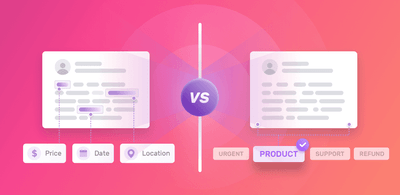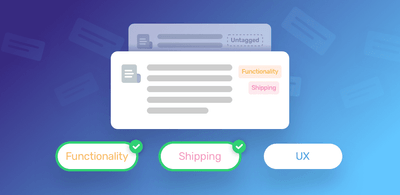Automate Ticket Classification with AI

It’s never been easier for customers to get in touch with businesses – on social media, in-app surveys, review sites, emails, chats – any time of the day, wherever they are.
So, what happens with all these conversations?
Most companies use help desk software, which centralizes customer feedback and helps agents automatically sort support tickets into categories.
While this removes some of the manual work of ticket tagging, ticket classification systems in help desk software are rather basic, and a lot of tickets end up being assigned the ‘other’ tag – or a broad tag that doesn’t accurately describe the problem.
That’s where ticket classification with machine learning comes in.
Learn more about ticket classification with machine learning, how it works, and some of the tools you can use to get started with advanced ticket classification right away.
It’s easier to implement than you think, and can also help automate your customer support processes to make your business even more efficient.
- What Is Ticket Classification?
- Why Is Ticket Classification Important?
- Help Desks for Ticket Classification
- How to Automate Ticket Classification with AI
- Create your Own Ticket Classifier with Machine Learning
Let's start your journey towards customer service automation!
What Is Ticket Classification?
When an issue or support ticket appears in your help desk, it needs to be processed and assigned a tag (or category) so that it’s routed to the correct team member. This will either be manual, which involves reading the ticket and manually assigning a tag, or automatic, which involves setting up rule-based systems, which tend to follow the rule of ‘IF X happens THEN do Y’.
Manual classification systems are often complicated and cluttered, and support agents struggle to assign a category. After spending endless hours going through tickets, they’ll often end up assigning the ‘Other’ tag to get through this tedious task faster.
Rule-based ticket classification systems, however, are not entirely accurate or efficient either. You’ll need to rewrite new rules and actions for new customer issues. If a new customer issue crops up, a rule-based system will not recognize it straight away, meaning new issues won’t be flagged immediately. If they’re urgent, then this could result in customers churning.
Ticket classification with machine learning solves this problem, since advanced AI tools are able to learn, adapt, and determine actions to take, without human input.
Instead of humans interpreting content and categorizing it, automatic ticket classification with machine learning uses natural language processing (NLP), which helps machines process, understand, and generate human language in a fast, consistent, and cost-effective way.
Perhaps you want to improve customer response times by routing your tickets to the correct teams as quickly as possible. Using text classifiers, you can tag tickets by language, topic, or channel (Twitter, email, live chat, etc), and route them to the correct team member or department based on these tags.
Let’s say you have a ticket from a customer who is asking for a refund. A topic classifier would tag this ticket as Refunds, in which case it would be sent to the accounts department. You could also use an urgency detection model, which can flag urgent tickets by analyzing their content for expressions such as right away, immediately or ASAP, and route these to teams that deal with urgent tickets.
Why Is Ticket Classification Important?
Correct ticket classification helps businesses sort their unstructured data, which provides many more valuable insights than structured data. Text data explains the ‘why’ behind the numbers, so you can know exactly what your customers need from your products and services.
But, as companies receive more customer queries and customer feedback, it’s harder for support agents to keep up. That’s why ticket categorization with machine learning is key. Not only is it scalable, it’s also fast and highly accurate if models have been trained correctly.
Let’s delve into the benefits of automated ticket classification with machine learning below:
It's Scalable
Rising customer issues, queries, and requests don’t necessarily mean you need to hire more staff. Ticket classification with machine learning automatically tags hundreds of support tickets in seconds, as opposed to hours. In other words, you can sort millions of pieces of data at a fraction of the cost of manual tagging, save time, and avoid burdening teams with tedious and repetitve tasks.
Real-time Analysis
The big advantage of machine learning is that ticket categorization tools can work around the clock, so you can respond immediately. Plus, if there’s a problem on social media that appears to be escalating, you’ll be able to detect and solve it straight away before it turns into a larger issue.
Consistent Criteria
As your support tickets, emails, chat conversations, survey responses, and so on, start to increase, you won’t have to worry about bad quality tagging. Ticket classification with machine learning enables you to tag your tickets accurately because it applies the same criteria to measure each set of data, plus a machine will never be subjective, lack alertness, and rush through tickets without understanding them properly.
Help Desks for Ticket Classification
Most customer service teams use help desks to manage their workflows and streamline their processes. While most help desks use rule-based systems to sort tickets, there are more and more businesses upgrading their help desk software with AI tools.
Zendesk, HelpScout, Freshdesk, Salesforce, for example, are omnichannel support desks that allow you to easily integrate AI tools, including chatbots, automated ticket classification with machine learning, and automatic data collection and reporting.
With AI software, such as MonkeyLearn, you can start classifying your tickets right away.
MonkeyLearn is a text analysis tool that allows you to classify your tickets in various ways. It also offers seamless integrations with numerous help desks, some of which we’ve mentioned above, so you can connect ticket classification models with your apps, quickly and easily, without typing a single line of code.
Sounds too good to be true, right? Well, thanks to MonkeyLearn’s intuitive interface, AI classification tools are really simple to use. Now that you know how accessible machine learning tools are, let’s take a look at some of the ways in which you can classify your tickets with MonkeyLearn.
How to Automate Ticket Classification with AI
There are many ways in which you can automate ticket classification, and the one you choose will depend on various factors.
In customer service, classifying support tickets by topic, sentiment, urgency, and language are the most popular approaches, and MonkeyLearn offers ticket classification models for all four:
Topic Classification
By classifying your tickets by topic or theme, you’re able to automate ticket routing in your help desks, so that each ticket is sent to the person best equipped to deal with each issue.
For example, let’s say Amazon receives an issue about a package that says delivered, but the customer never received it. Using MonkeyLearn’s e-commerce support ticket classifier, you can automatically classify this ticket as a Shipping Problem as soon as it drops into your help desk. Here’s an example of how MonkeyLearn processes this information:
A topic classifier can also be useful for organizations that have more than one product and different support teams responsible for each one. In this instance, you’d use a topic classification model to categorize tickets by product name (e.g. Google Drive, Google Phone) and then by topic issues that fall under each product (e.g. Login issues, Refunds, etc).
Urgency Classification
If you decide to classify your tickets by urgency, then you can use MonkeyLearn’s urgency detector. This pre-trained model enables you to detect issues that need immediate action, for example social media mentions that contain expressions such as ‘right away, immediately, ASAP’ would be classified as Urgent by MonkeyLearn’s model. You might want to tailor this urgency detector to your business; perhaps by creating a model that recognizes messages from the CEO of a company or premium subscribers. While these might not be urgent issues, you might want to prioritize these tickets over others. Take a look at how ticket classification by urgency works, below:
Sentiment Classification
Ticket classification by sentiment is one of the fastest ways to sort tickets. The pre-built sentiment analysis model available with MonkeyLearn, for example, allows you to classify the polarity of each ticket (e.g. Negative, Neutral, and Positive). In the same way that an urgency detector prioritizes tickets, based on expressions denoting urgency, a sentiment analysis model is also able to prioritize issues, but based on expressions that indicate negativity.
Ticket classification by sentiment can be extremely useful for detecting a serious issue by monitoring ratios of negative to positive tickets over a period of time. Let’s say there’s a sudden increase in negative comments; this might suggest that there’s a serious issue affecting a large group of customers, such as a bug or a video of bad customer service that’s gone viral! Let’s take a peek into how sentiment analysis with MonkeyLearn works:
These ticket classification methods can all be combined to prioritize and route tickets even more effectively. Once you’ve run sentiment analysis on a batch of support tickets, for example, you can run a topic analysis on each group of sentiments to find out which topics your customers are talking about negatively or positively. This is called aspect-based sentiment analysis.
Language Classification
If you work for an international company, chances are you receive customer issues in various languages. However, instead of agents wasting time bouncing issues from one team to another until they land in front of the correct localized teams, MonkeyLearn’s language classifier is able to route tickets to the right person, right away. Let’s take a look at this example below:
This classifier correctly classified this customer issue as Spanish. Oh, and did we mention that it can recognize 49 different languages!
Create Your Own Ticket Classifier with Machine Learning
Once you’ve tested MonkeyLearn’s pre-built models, you’ll be tempted to build your own model to get even more accurate results when classifying your tickets. Luckily, our user interface is really easy to use and, after signing up for free, you can have a go at building your own ticket classifier by following these 6 simple steps:
1. Create a New Classifier
Go to the dashboard, click create a model, and choose classifier:
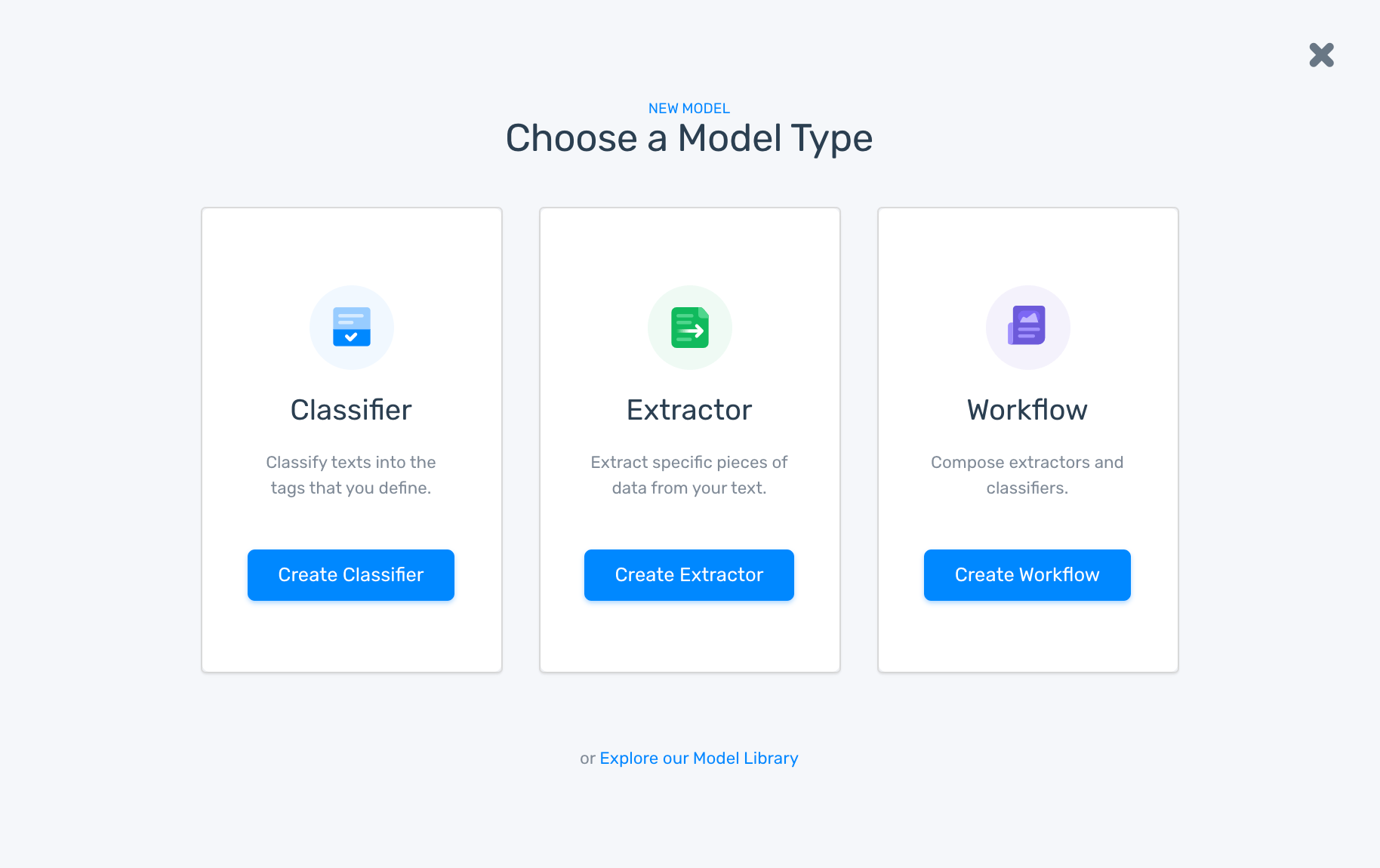
2. Upload Training Data
You’ll need to upload support tickets to train your classification model. You can upload data using a CSV or Excel file.

3. Define the Tags for your Model
As we mentioned earlier on, you’ll need to define a set of tags that are best suited to your organization. Once your classifier has been trained, it will automatically categorize tickets using these tags. Once you’ve defined them, add them to your model:
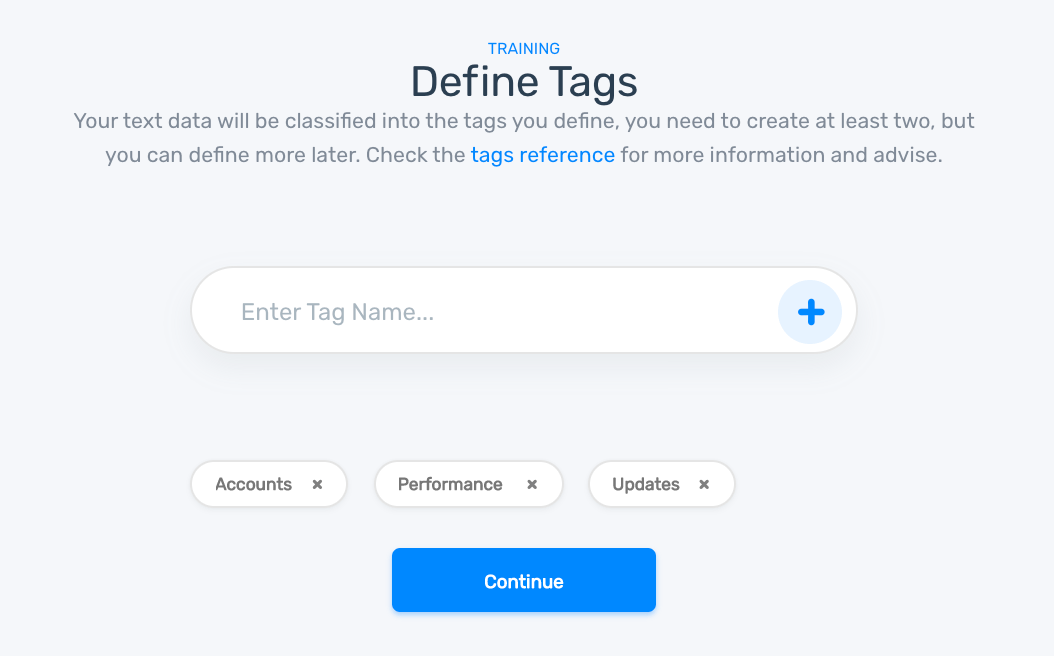
4. Train your Ticket Classification Model
Finally, you’ll need to tag each example with the expected category to start training the machine learning model:
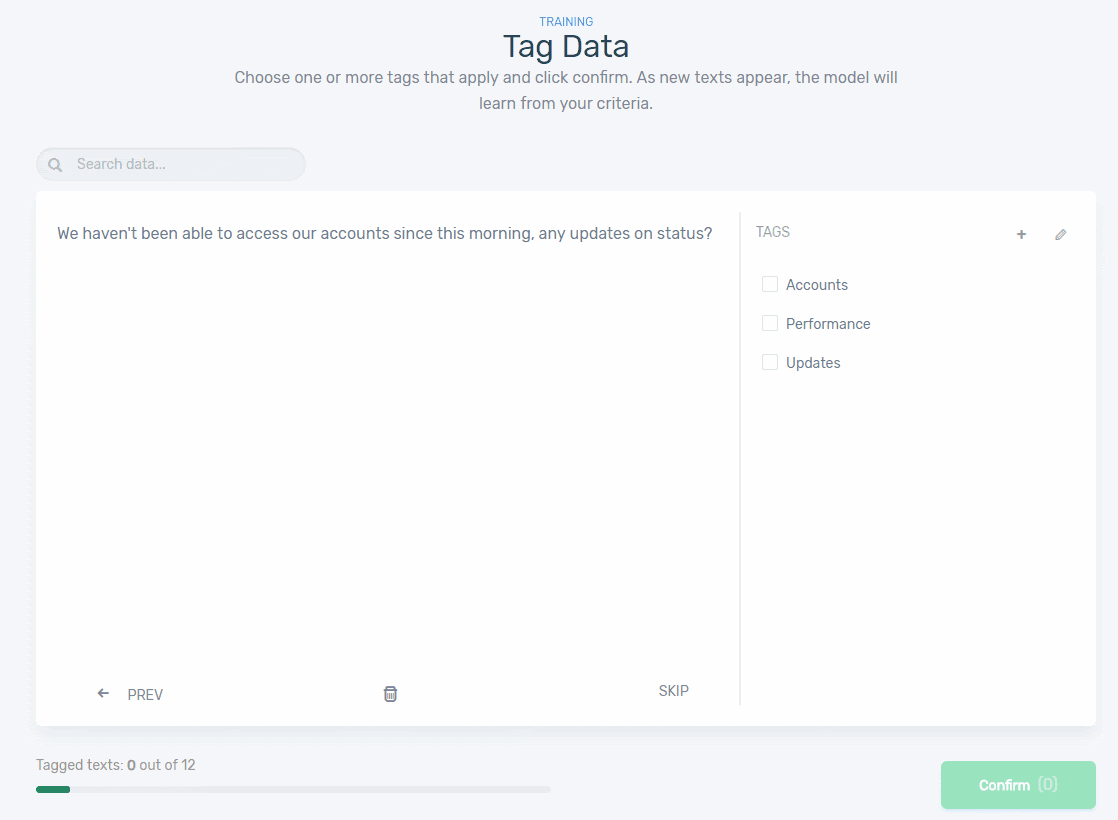
5. Time to Test Your Classifier!
Once you’ve finished creating your ticket classification model, you’ll need to test it in the ‘Run’ tab. You can do this in two ways, either by choosing ‘demo’ and writing new text directly in the text box field, or by choosing ‘batch’ and uploading new, unseen tickets. This way, you’ll be able to see how accurately your model sorts data:
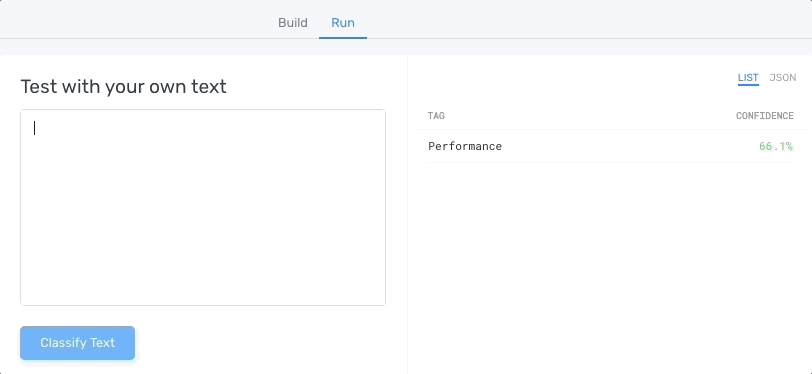
MonkeyLearn provides some useful tools to determine how well your model is performing in the ‘stats’ section, such as classifier stats (e.g. accuracy, F1 score, precision, and recall) and a keyword cloud for each category:

If you want to improve the accuracy of your classifier, continue training it by clicking the ‘train’ tab. Here, you can tag more data and retag incorrectly labeled examples.
6. Put Your Ticket Classifier to Work!
Now that you have trained your classifier, the final step is to integrate it into your customer service software. MonkeyLearn offers some handy integrations such as Zendesk to make it easy to put a model to analyze and tag data in the apps you use every day. Alternatively, if you know how to code, you can integrate the model using the API with your favorite programming language.
Wrap-up
Tagging tickets has always been an important task within customer service. However, with increasing amounts of customers taking to social media platforms, review sites, and more to complain, it has become harder for support agents to stay on top of all their incoming tickets.
While ticket triaging is simple, it’s time-consuming and tedious.
Traditional methods of manually tagging and routing tickets are no longer sustainable, which is why more and more organizations are turning towards ticket classification with machine learning. By equipping their help desks with AI tools, organizations are able to complete simple tasks faster and more accurately and free human agents to focus on more fulfilling tasks. Automated tools are also scalable, meaning you won’t have to hire extra agents if there’s a sudden spike in tickets.
The best part is that AI-equipped ticket classification tools are readily available, easy to use, and less costly than implementing your own AI solutions. These tools make machine learning accessible to customer service teams and can be easily implemented within your processes on a subscription basis.
MonkeyLearn, for example, can help you get started with AI ticket classification for free, and comes with many pre-built ticket classification models. You can also integrate them into your help desks, as well as tailor them to your company, all without having to write a single line of code. Ready to try out ticket classification for yourself? Request a demo from MonkeyLearn and start automating ticket categorization with AI.

Federico Pascual
October 3rd, 2019




